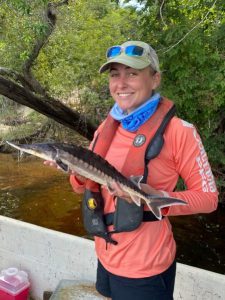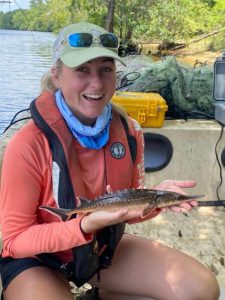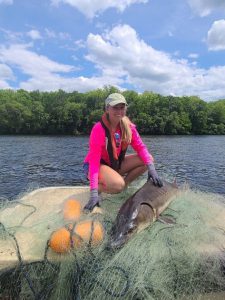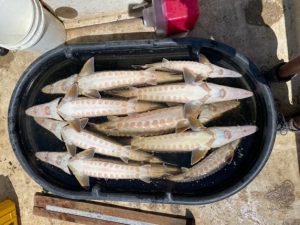Written by 2021 UF/IFAS NCBS Summer Intern, Ashlyn Posey

First, a thanks
This summer I have had the opportunity to work with USGS’s Mike Randall and Melissa Price, under Principal Investigator Margaret Lamont, on sturgeon ecology and conservation. Coming into this internship I knew very little about sturgeon, and Mike and Melissa eagerly shared so much of their experience and knowledge with me. All three of these individuals also shared with me valuable advice for my graduate school search. UF NCBS’s Travis Thomas also mentored me this summer through this internship and his research. I would like to thank all of these individuals for their help, guidance, and push into my professional career.

On the Suwanee
Our days consisted of boat trips throughout the Suwannee and Gulf Estuary, fishing for juvenile sturgeon. To catch the fish, we utilized drift nets. Mike and I would deploy the net off the front of the boat as Melissa drove us in reverse across the river. After the net was deployed, we would enjoy the beauty of the river and chat about science as we waited about 15 minutes for the net to fish. As we pulled the nets in, we would place the sturgeon in a pool of water for processing once we finished retrieving the nets.

We often caught gar, catfish, and once caught red drums as bycatch in out nets (unharmed of course). All of the sturgeon caught would be scanned for a PIT tag and receive one if it was not a recatch. From the sturgeon, we would take a fin ray sample for aging, a tissue sample for genetics, a length, and a weight. If the individual was within the size range we were looking for (<750mm), Mike would surgically place an acoustic tag into the fish for movement monitoring. After processing, we would return the fish to the river and watch to make sure they swam successfully back to the bottom!
 About Gulf Sturgeon
About Gulf Sturgeon
The Gulf Sturgeon is sometimes referred to as a “living fossil” because they have existed since the time of the dinosaurs. This fish can grow up to 8 feet long and weigh up to 200lbs! Sturgeon are benthivores and forage and feed on invertebrates at the bottom of the river and estuary. Within the 20th century, this species nearly went extinct due to overfishing (massive caviar producers!), dam construction, and habitat degradation. The species was listed as threatened under the Endangered Species Act in 1991. The recovery of this fish is a slow and steady process because these fish are long-lived and (20-25 years, maximum 60 years) and do not sexually mature until they are about 8 years old (at the earliest). The survival of the younger recruitment classes to reach sexual maturity is key to this species recovery. Currently, the Suwannee has the healthiest population of Gulf Sturgeon!

 0
0

Comments are closed.